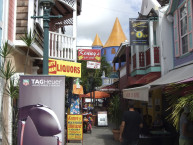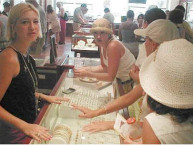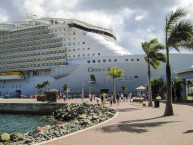St Barts
 The Caribbean playground of the rich and famous, the diminutive 25-square-kilometre ST BARTH�LEMY (St Barts) looks like it’s been plucked from the C�te d’Azur and dropped into the Antilles. Situated 25km south of St Martin and 175km north of Guadeloupe, the
The Caribbean playground of the rich and famous, the diminutive 25-square-kilometre ST BARTH�LEMY (St Barts) looks like it’s been plucked from the C�te d’Azur and dropped into the Antilles. Situated 25km south of St Martin and 175km north of Guadeloupe, the
boomerang-shaped island is sprinkled with picturesque red-roofed villas and edged by some of the Caribbean’s loveliest beaches and bays . Many of the beaches are only accessible by sea, giving the island a rare sense of seclusion . Even the most beautiful stretches – Grande Saline, AnseColombier and Anse Gouverneur – never get crowded and, thanks to building laws forbidding big resort developments, everything is small-scale, including the capital, Gustavia , whose tallest buildings are shorter than the highest palm trees.
St Barts’ privacy doesn’t come cheaply, but considering the throngs that crowd the island’s neighbours in high season, paying a little more for some personal space can make all the difference
St Barth�lemy was spotted by Columbus in 1493 and named for his younger brother, Bartolomeo. The first French delegation to settle the island, in 1648, came from nearby St Kitts. Their effort was disastrous, however, as native Caribs massacred the lot in 1665. It was almost a decade later before a second attempt, this one by Norman and Breton Huguenots, was made. Under their reign, Gustavia’s hurricane-proof harbour became a popular mooring port for buccaneers, who carried plunder from Spanish galleons in their holds; one legendary pirate, Montbars the Exterminator, even set up headquarters here.
Over a century later, in 1784, France’s Marie-Antoinette ceded ownership to Sweden’s King Gustaf II in exchange for free-port rights in Gothenburg. But after serving as an American-friendly port during the Revolution and, later, the War of 1812, Gustavia suffered a devastating fire in 1852 that proved too costly for the Swedes. They sold it back to France in 1878, for 320,000FF (US$45,700 today), and the French condition that it remain a duty-free port. The island’s administrative status changed in 1974 it, when came under neighbouring Guadeloupe’s jurisdiction
Two of St Barts’ best undeveloped beaches are approached from well-marked secondary roads south of St-Jean and Lorient. The local favourite is the white-sanded Grande Saline that backs a salt pond at the island’s core. The other, the facility-less Anse Gouverneur , lies around another headland, at the end of a steep descent that passes hidden villas and marvellous views of St-Jean. You can eat near Grande Saline at Le Grain du Sel , a chilled-out place serving burgers and sandwiches; Le Tamarin (closed June-Oct) a hammock-strung eatery offering fine salmon and langoustine ; and Le Gommier , a creole joint serving good local fare.
St Barts’ capital, dollhouse-size GUSTAVIA , is an appealing blend of red-roofed villas and heavy-set grey-stone buildings that plays second fiddle to its deep U-shaped harbour, where yacht-watching over a bottle of wine at a waterfront caf� ranks as the unofficial town sport. A close runner-up for that title is shopping , as dozens of duty-free boutiques line the main drag, Rue de la R�publique.
The town’s few historical sights can all be seen in under an hour. The architec-tural highlight, the chunky circa-1800 Swedish Wall House , anchors the west side of the harbour from Place Vanadis , named for the last Swedish military vessel to leave the island after the 1878 French repossession ceremony. The former storehouse now hosts the mundane Mus�e de St Barth�lemy (Mon 2.30-6pm, Tues -Fri 8.30am-12.30pm & 2.30-6pm, Sat 9am-1pm; �2), a modest collection of tools, maps and other oddities. On the south side of the port, the cheerful 1855 St Bartholomew Anglican church, with its sandstone facade topped by a minute wood-shingled belfry, contrasts sharply with the sombre, Hispanic-influenced Notre-Dame de l’Assomption nearby. A short walk west from both churches is Gustavia’s small beach, the pinkish seashell-covered Anse du Grand Galet , not surprisingly a boon for beachcombers. At the other end of town, a red-topped lighthouse graces a promontory once home to Fort Gustaf , though scant evidence of its military origins remains save the odd cannon and sentinel; the main attraction today is the magnificent view of Gustavia and surrounding islands.
From St-Jean, the road makes a short climb before descending into quiet LORIENT , the site of the first French settlement in 1648. Today, its smallish bay is popular with windsurfing aficionados. Otherwise, the town’s main appeal is its proximity to St-Jean. The best accommodation , the recently reopened La Banane on the way into the village (tel 0590/27 68 25, fax 27 68 44, ; US$420 including breakfast), has eight ultra-stylish creole cottages and two Zen-retreat-like pools. La Normandie , on route des Salines (tel 0590/27 61 66, fax 27 98 83; US$50-75), is a good-value option with a pool and simple but agreeable A/C rooms. Lorient’s restaurant scene is confined to K’F� Massa� (tel 0590/29 76 78; dinner only; closed Tues), a sophisticated French-creole eatery at the entrance to town, and Jojo Burger , with inexpensive fried chicken and delicious burgers near the beach. The organic Vitolive , on route des Salines (Mon-Sat 10am-7pm), offers tasty tapas, sandwiches and free olive-tastings daily.
A couple of kilometres past Lorient, the main road passes the island’s swankiest neighbourhood, POINTE-MILOU , a collection of stunning villas on a rocky cliff. The lone hotel here, Christopher (tel 0590/27 63 63 or 1-800/763-4835, fax 0590/27 92 92, ; US$460 with breakfast), is tucked along the base of the point, with 42 well-appointed rooms and a terrific free-form pool. Dining -wise, the cosy Ti St-Barth (tel 0590/27 97 71; dinner only) is recommended for its blend of creole and French fare.
St Barts’ busiest enclave, the twin-beached ST-JEAN , lies so close to the airport that incoming planes practically land on the longer of the two white-sand crescents. This technicality hasn’t prevented the area becoming the island’s premier resort though; its first hotel, the spectacular Eden Rock , was established here in the 1950s atop the quartzite promontory that divides the two stretches. Since then, St-Jean has become the most happening spot on the island after the capital, with plenty of shops, restaurants and bars, both on and off the sand. The bay itself, protected by coral reefs, has decent snorkelling and windsurfing conditions.



